
![]()
BACKGROUND – TALKING POINTS – DISPELLING FALSEHOODS – ACTIONS – PERSON OF THE WEEK – STORIES

![]()

‘The vile lottery of Jewish lives continues’
As hostages are being released in a slow and painful process, the captives and their families are suffering devastating psychological effects, now 500 days since the brutal 10/7 massacre. The families of hostages still held by Hamas and Palestinian Islamic Jihad in Gaza have been tormented each week as they wait to find out if their children, partners and parents will be released – or are even alive.
Each week increases the likelihood that these families will receive their kidnapped family member in a coffin. The world recently learned that the red-headed children of the Bibas family and their mother – iconic symbols of the hostages throughout the war – died in Hamas captivity. Their husband and father, recently released hostage Yarden Bibas, had been clinging to hope that his wife and two young children would be returned alive.
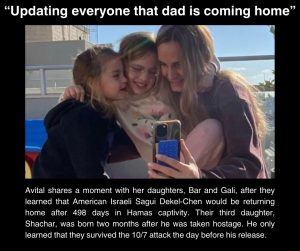
The Iran-backed terrorist organizations released Russian-Israeli Sasha Troufanov, Argentinian-Israeli Iair Horn and American-Israeli Sagui Dekel Chen on Feb. 15. It was heart-warming news for their families, but heart-breaking for the families of hostages yet to be released in Phase 1 of the ceasefire deal.
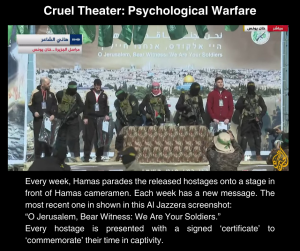
Survivor Testimonies: ‘Piles of bodies, cries of rape’
“You grow up on stories from the Holocaust and the images of these emaciated bodies,” recalled Avihai Brodutch, whose wife and three children – ages 4, 9 and 10 – were held in Hamas captivity for 51 days in 2023. “And now your family has gone through this.” Avihai was wounded, but escaped from his kidnappers on 10/7. The Wall Street Journal recently profiled several of the hostages released in a Nov. 2023 ceasefire deal – and their long, wrenching recoveries.
Avihai’s father: “So many people died around him. They saw bodies everywhere, and houses in flames. A lot of my friends and neighbors who we knew well had their families killed. So it’s a part of our life now: death.”
Mia Schem, 22, was one of the first faces of the kidnapped Israelis: “The feelings of Gaza won’t go away. People think you are out, you are safe and that it’s over. But it’s not. Every day is a battle to get up and fight. My body is still tense.” Mia developed epilepsy – recurrent seizures – after only 50 days of captivity. A Hamas terrorist shot her right arm at point blank range, destroying her elbow. Her arm is a few inches shorter after four surgeries. Mia recalled witnessing cries of women she thinks were being raped at the Nova music festival, where she also saw piles of dead bodies.
Luis Har, 71, was abducted from his kibbutz: “We were punished for crying, punished for laughing, punished for missing your parents. They want you to be a robot, to act according to their needs. One time I cried and I was beat up for it.”
An Israeli psychotherapist described how the released child hostages are struggling with guilt. One told her mother: “You know, mommy, we were caught because I was crying.”
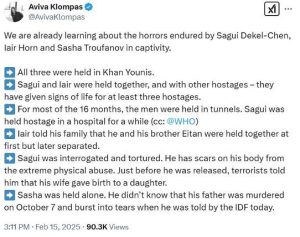
Recent Survivor Statements: ‘Forced to fake her own death’
The recently released hostages were held for nearly 500 days – suffering from excruciating torture, psychological torment and debilitating injuries. Hamas forced Daniella Gilboa to stage her own death during captivity to make it look like Israeli forces killed her in an airstrike. Her mother, Orly, described the nightmare: “One of the terrorists came to her with a camera and told her, ‘Daniella, I must take a picture of you, like you are dead.’ She started to cry, begging him not to do it. When she saw me and my husband for the first time after her release, she apologized for how she caused us to feel this whole time.”
Merav Leshem Gonen spoke for her daughter: “Romi’s right hand is paralyzed and nonfunctional from her untreated gunshot wound. Romi is still in pain today. For a year and three months, my daughter suffered excruciating pain. She was given no painkillers, no medication – nothing.”
Multiple hostages were held in the homes of terrorists or civilians. They were forced to cook – even while being starved – and care for children. The men still being held were described as being in dire straits: one has been shackled by his legs the entire time and another lost consciousness from being beaten – other hostages thought he was dead. Female hostages were starved, beaten, forced to eat donkey food and still cannot bring themselves to talk about horrors endured on 10/7. The silver lining is that released hostages reported seeing many of them alive – the first signs of life for their families since their abductions.
American Israeli Keith Siegel: “I am a survivor. I lived in constant fear. I was starved and I was tortured, both physically and emotionally.” Two weeks after his release, former hostage Ofer Calderon has been hospitalized with pneumonia.
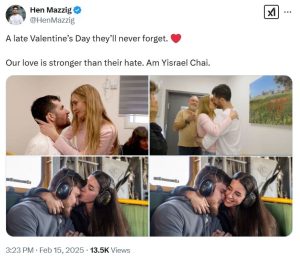
Resilience: ‘I chose the path of faith’
Despite torture, malnourishment and not even being allowed to see the sky, many of the recently released hostages remained resilient. They did not know if they would survive – or if their families survived. Freed hostage Amit Soussana credited Liri Albag with saving her life in captivity by convincing the terrorists that she was not a soldier. All the hostages did their best to live day by day in captivity.
Gadi Moses, 80, focused on the day he would return home to rebuild his community: “I never broke, I never cried – I just waited for the moment I would be free.” He held imaginary conversations with loved ones, took daily walks in his cell counting floor tiles to measure the distance and solved math puzzles in his head.
Some hostages turned to their faith or became more religious in captivity. Agam Berger: “I chose the path of faith. We didn’t eat bread on Passover and tried to fast on Yom Kippur. With the path of faith, I have returned – thank you to all the people of Israel and our heroic IDF soldiers. There is no one like you in the world!” Agam was released one week after her friends: “Agam braided our hair before we left. It felt like she was giving us a piece of her strength to carry with us.”
Daniella Gilboa, one of the hostages, was able to see some televised coverage of thousands of Israelis rallying for their release: “Daniella saw what was happening here. She knew we were fighting for her.” Naama Levy – the images of her in blood-soaked sweatpants were an enduring image: “While I was still in captivity, I saw how you were fighting for me. Thank you, everyone, I love you!” Daniella’s boyfriend, Roi, proposed to her following her release.
Hostage David Cunio was recently seen alive in Gaza – his first sign of life. His wife Aloni: “This gives us so much strength and so much air to breathe. There is no way to describe how much happiness I’ve been feeling from the moment that we heard the news. It gives us renewed strength to fight until he is returned, until everybody is returned.”
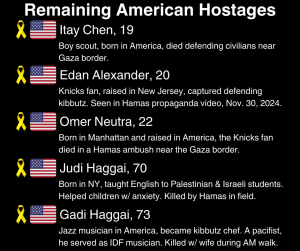
Additional Hostage Headlines
![]()

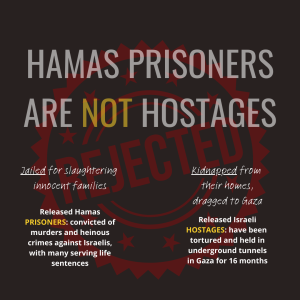
![]()

YOU MAY HEAR: There is a risk of widespread famine in Gaza.
Reality: This false claim began immediately after Oct. 7 and has been repeated by known anti-Israel organizations and individuals. A recent report revealed that food entering Gaza exceeded humanitarian requirements. Hamas gunmen were caught on tape accusing Hamas leaders of hoarding humanitarian aid. Israel also is meeting its obligations under the ceasefire deal to allow at least 600 trucks to enter Gaza every day.
YOU MAY HEAR: Gaza is an open-air prison.
Reality: This false claim was prominent in the years before the 10/7 attack. Once Israel started attacking Iran-backed Hamas terror targets in Gaza, anti-Israel activists flooded social media with pictures and videos of life in Gaza – bustling shops, glamourous hotels and picturesque beaches. About 150,000 Gazans traveled annually through its border crossing with Egypt – business trips to China, vacationing in Turkey and student visas to study abroad. In 2022, 424,000 Gazans entered Israel – with work permits and to receive medical treatment.
![]()

Become an influencer: Use our messaging to spread awareness
Use the facts in the Background and the Talking Points to amplify the stories of the released hostages, their families and the continuing barbaric actions committed by Hamas – against Palestinians and Israelis. Whether you are talking with family, friends or coworkers, or posting on social media, help reach and teach someone who does not have an understanding of the issues vital to the Jewish community.
![]()

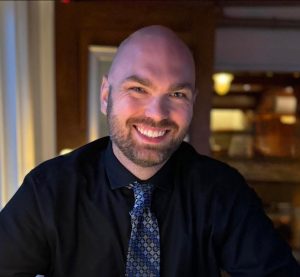
Principal Jesse McMillan | Westfield Middle School, Westfield, Mass.
When swastikas – Nazi Germany’s symbol of hate and violence – started appearing at a middle school in Westfield, Massachusetts, last month, Principal Jesse McMillan leaped into action.
McMillan quickly alerted administration and parents, arranged for education sessions for all students, and began working with the local Jewish Federation to develop age-appropriate educational resources for his school, which has a diverse population of working-class Hispanic, Black, white and Ukrainian children, and a minority of Jewish students.
“Hate symbols of any kind have no place in our school community,” McMillan wrote in his letter to the school community. “Such actions create an unsafe learning environment, inflict real harm on our students and staff, and fundamentally contradict our educational mission. I want to assure you that we take these matters very seriously,” including imposing severe disciplinary consequences.
McMillan says response from students has been very positive, and the incidents have stopped. “One student asked why we waited so long to have these programs,” he told The Focus Project.
He said the real measure of success will be in creating lasting change within the school culture.
“Though this work can be emotionally demanding, the alternative – staying silent in the face of hate – is simply not an option. Our students are watching how we respond in these moments, and they deserve to see strong leadership that upholds their dignity and ensuring that every member of our school community feels valued, respected and safe.”
![]()


Stories Impacting American Jews
Stories From Around the World
Stories Impacting the U.S. and Israel
![]()
In light of the surge of current relevant news, please subscribe to our Daily News Brief, a digest of critical news headlines curated from thousands of media addressing issues that affect the Jewish world.
![]()

This content is developed by The Focus Project in partnership with MERCAZ USA. The Focus Project distributes weekly news and talking points on timely issues concerning Israel and the Jewish people, including antisemitism, anti-Zionism and the delegitimization of Israel. It represents a consensus view across a spectrum of major American Jewish organizations. MERCAZ USA recognizes and respects the diversity of views on these issues among its readers and the community at large.
![]()